 It’s the season of outdoor parties and a summer BBQ is the perfect way to enjoy time with friends and family! For some tips on how to make this year’s get-together your best one yet, check out my list below:
It’s the season of outdoor parties and a summer BBQ is the perfect way to enjoy time with friends and family! For some tips on how to make this year’s get-together your best one yet, check out my list below:
Set the Mood: String up fairy lights, plug in a radio with some of your favourite tunes in the background, put out a lawn rug, and throw a fresh tablecloth over your outdoor dining area. A few quick items can really spruce up the yard and make it feel ready for guests!
Don’t Forget to Play: If you’re hosting an adult-only BBQ, setting up a table for a card game or getting out your cornhole boards can be a great way to pass the time and get in some laughs. If you have children in attendance, consider setting up a lemonade stand or fill some water balloons for an extra splash!
Choose Your Mains: It can be easy to get carried away grilling steaks, fish, chicken, hot dogs, burgers – you name it! For a more successful party, choose two options. Maybe you go with hot dogs and veggie burgers, or perhaps fish and chicken. Choose items that cook well on the BBQ together and suit the tone of your get-together.
Have Drinks on Hand: Set up a table with pitchers of fun summer drink concoctions (alcohol optional!) or consider filling a kiddie pool or wheelbarrow with ice to keep those beers chilled all afternoon.
Put Out Snacks: This may seem like a no-brainer, but having a table filled with fun ‘grazing’ snacks can help stave off any stress about perfectly grilling your meals! Try a veggie and dip tray, fruit shish kabobs, or a charcuterie board of cured meats and cheeses.
MORE RELATED BLOG POSTS
- How to Calculate Mortgage Trigger Points?
- Adapting Your Finances to Inflation
- Housing Market Predictions?
- Time to Check-In with your Mortgage!
- Purchasing a Home
- Refinance Your Mortgage
- Home Equity Loan – Access up to 95% of the value of your home
- Improving Your Financial Direction
- 2023 Financial Resolutions
- Post-Holiday Debt Consolidation
- Alternative Lending
- What to Know about Second Mortgages
- Family Day Ideas
- Preparing for the Spring Market
- Fraud Awareness Month
- Homeowner Insurance 101
- Appraisal Tips for Success
 With the current interest rates and economic scenarios, many Canadians may be looking for ways to bring in some extra cash. One option for this is to put your home equity to work and consider renovating your basement into a legal income suite! You can do this by using a secured credit line (home equity line of credit or HELOC) to help fund the upfront cash to make changes to your home.
With the current interest rates and economic scenarios, many Canadians may be looking for ways to bring in some extra cash. One option for this is to put your home equity to work and consider renovating your basement into a legal income suite! You can do this by using a secured credit line (home equity line of credit or HELOC) to help fund the upfront cash to make changes to your home. Economic Insights – Canada Real Estate Market.
Economic Insights – Canada Real Estate Market. efore banks or lending institutions can consider loaning money for a property, they need to know the current market value of that property.
efore banks or lending institutions can consider loaning money for a property, they need to know the current market value of that property.